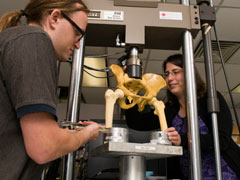What Goes Around, Comes Around
By Jim Oldfield
Calculating bone properties of metastatically involved rat spines with 3-D micro-computed tomography in an orthopaedic biomechanics lab is not how most teachers envision spending their summer break. Rosa Assalone, however, is not like most teachers. The grades 11 and 12 Bishop Ryan secondary school physics instructor travelled from Hamilton to Toronto to spend three weeks in August at Sunnybrook Research Institute (SRI) working with Dr. Cari Whyne's lab group as part of the Teachers' Science and Technology Outreach Program (TSTOP), a Ministry of Research and Innovation initiative that brings together academic researchers and teachers to help students grasp just what science can do.
The return, says Assalone, was worth the investment: "It really turned out well in terms of learning things to bring back to the classroom."
Assalone, who did TSTOP last year at McMaster University, was impressed with the technology and range of experience offered at SRI. In addition to analyzing 3-D micro-computed tomography, she used pedicle screw insertion software to simulate spinal fusion surgery, saw a demonstration of BrainLAB (a wireless, image-guided surgical navigation system), observed the molecular effects of radiation treatment in preclinical models of spinal metastases and attended lab meetings. She also found Whyne's diversely skilled lab members welcoming and helpful: "They're all working on different projects or specific areas of larger projects, but they sat down with me and shared what they were working on."
For Whyne and her lab, in turn, hosting Assalone was a chance to give back to the community and perhaps have a long-term impact on impressionable students. "I think outreach to teachers and students is very much a valuable investment, because it creates linkages to science and technology that can directly motivate students to go into research," says Whyne, who is the director of the Holland musculoskeletal research program.
A day visit by Assalone's students to Whyne's biomechanics lab, planned for the coming school year, will help make manifest those positive associations. "It's good for students to get out of the classroom and actually see the potential for their careers, because it's really hard for them to imagine what they can do with physics after graduation," says Assalone. Seeing researchers with such varied backgrounds—engineering, veterinarian medicine, biology and medicine —working together toward common goals will also facilitate broader career thinking, she says.
Programs that provide that kind of perspective are relatively new in Canada. When Whyne was in high school, such options weren't available at the undergraduate level in Canada, she recalls. There were few women in engineering, and "hardly anyone could even tell me what engineering was," she says. It pushed her to get involved. While at the University of California, San Francisco, she did outreach with female students and primary school teachers, and back in Canada she was a mentor at girls' science camps, among other activities.
Preparing for maternity leave, Whyne brought TSTOP to the attention of Michael Hardisty, a research engineer in her lab, and he took up coordination of the program for SRI. Hardisty, who will begin a PhD at the University of California, Davis this September, had also done outreach and saw TSTOP as a mutually beneficial opportunity. "It's good for science to be integrated into society, and it's healthy for science to have the scrutiny from society that outreach provides," he says.
While Hardisty and Whyne plan to continue reaching out, and say they would do TSTOP again, the success of the program—like the success of students—hinges on teachers. Says Whyne, "For a teacher to take three weeks of their summer, unpaid, and spend that time in the lab—it's very impressive."
PDF / View full media release »


